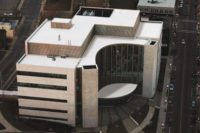Learning From Disaster: Devastating Events Play Key Role in Developing Roofing Standards




Because roofs perform so many critical building functions, it shouldn’t come as a surprise that many of the best sustainable roofing practices today are the result of failures and not successes. The kinds of failures that drive sustainable roofing frequently are massive in scale. Historic conflagrations such as the 1871 Chicago Fire taught us the importance of preventing the spread of fire from roof to roof, resulting in the well-known Class A, B and C fire classifications for roofing systems. Over the past century, other devastating fires have led to the development of hourly fire tests for roof assemblies that help prevent the spread of fire within a building and extend the escape time for occupants. Even as recently as 1953, we were still developing under-deck fire ratings such as the UL-1256 Steiner Tunnel and the FM 4450 Calorimeter due to the massive GM Hydramatic Fire in Livonia, Mich., where a 30-acre factory complex was completely engulfed in less than 20 minutes.
Severe weather events also have played a large role in the development of sustainable roofing standards. As an example, current standards for cool roofs can be attributed in no small part to severe heat waves and brownouts such as the Chicago Heat Wave of 1995. But perhaps the disasters triggered by hurricanes and similar severe storms have taught us the most about how sustainable buildings (and roofs) need to be designed. In 1992, Hurricane Andrew showed us that hurricane wind forces can be much more devastating than we had originally thought. As a result, wind design standards across the United States were bolstered, with minimum design wind speeds rising by 30 mph or more. And coastal jurisdictions such as Miami-Dade County went even further with the development of wind-borne debris standards and enhanced uplift design testing.
|
Commercial Roofing Boot Camp Want to learn more about resilience and other important roofing issues? Dr. Hoff is teaching a 10-week, online course titled “Commercial Roofing Boot Camp.” This course, offered in partnership with Roofing Contractor and Architectural Roofing & Waterproofing, will help interested roofing and construction professionals understand the key principles of modern roofing and how to apply the best tools to put these principles into action. For more information or to register, visit www.theCEcampus.com or http://bit.ly/BootcampARW |
Although Hurricane Katrina in 2005 may not have packed winds any stronger than Andrew, we learned the hard way about the effects of storm surges, and perhaps most importantly about the importance of a little-known part of wind design called “Building Risk Category.” Even though the Superdome in New Orleans obviously could pose significant safety risks in a severe storm, our building codes at that time assumed that large sports facilities would be evacuated and empty during hurricanes — and hence, “no harm, no foul” to potential occupants. Unfortunately, due to the unexpected severity of Katrina’s storm surge and the inadequacy of evacuation measures, the Super Dome became a critical storm shelter for thousands of New Orleans inhabitants, with disastrous results when the roof blew off. As a result of Katrina, building risk categories in codes were upgraded, and the lowest risk category was even eliminated.
Finally, Hurricane Sandy hit the East Coast in 2012, and we were given an object lesson again about the devastating effect storm surges can have on how a building can function effectively when external utilities and services are cut off. When buildings are isolated from the supply of fresh water and electricity, roofs can serve an important role in keeping building occupants safe and secure. Storm surges can wipe out critical utilities located in building basements, but power and water sources located on the rooftop can help maintain emergency lighting and water supplies. And thermally efficient roofs can help keep occupants comfortable until heating and cooling plants are put back into service.
Even though many advances in roofing technology have been the result of disasters, we should be very proud of the roofs we install and maintain today. Out of the tragedy of fires and storms, we have developed smarter, stronger and more resilient roofs. Hopefully these roofs will help keep our customers safe and secure the next time disaster strikes.
Looking for a reprint of this article?
From high-res PDFs to custom plaques, order your copy today!









